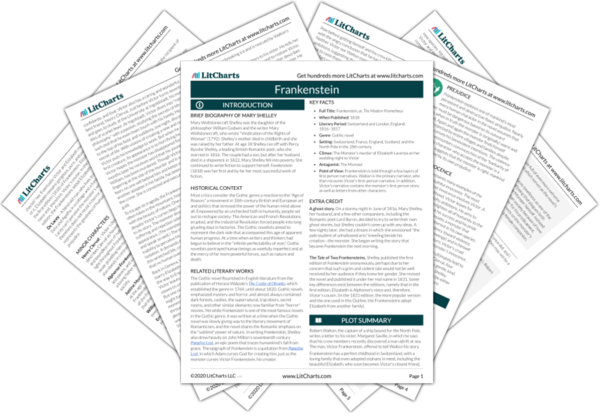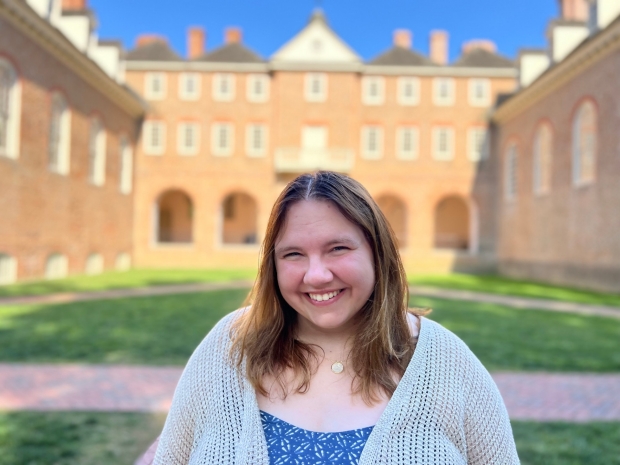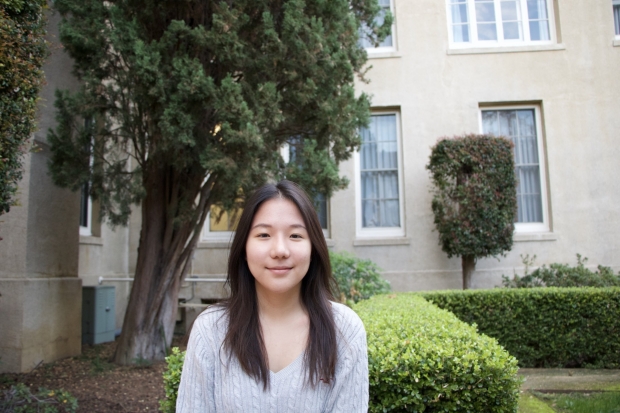Frankenstein: Essay Samples

Welcome to Frankenstein Essay Samples page prepared by our editorial team! Here you’ll find a number of great ideas for your Frankenstein essay! Absolutely free essays & research papers on Frankenstein by Mary Shelley. Examples of all topics and paper genres.

📝 Frankenstein: Essay Samples List
Frankenstein , by Mary Shelley , is famous all over the world. School and college students are often asked to write about the novel. On this page, you can find a collection of free sample essays and research papers that focus on Frankenstein . Literary analysis , compare & contrast essays, papers devoted to Frankenstein ’s characters & themes, and much more. You are welcome to use these texts for inspiration while you work on your own Frankenstein essay.
- Feminism in Frankenstein by Mary Shelley Genre: Critical Analysis Essay Words: 2280 Focused on: Frankenstein ’s Themes Characters mentioned: Victor Frankenstein, the Monster, Elizabeth Lavenza , Justine Moritz
- Frankenstein’s Historical Context: Review of “In Frankenstein’s Shadow” by Chris Baldrick Genre: Critical Writing Words: 1114 Focused on: Historical Context of Frankenstein Characters mentioned: the Monster
- Science & Nature in Frankenstein & Blade Runner Genre: Essay Words: Focused on: Themes of Frankenstein , Compare & Contrast Characters mentioned: Victor Frankenstein, the Monster
- Romanticism in Frankenstein: the Use of Poetry in the Novel’s Narrative Genre: Essay Words: 1655 Focused on: Literary analysis of Frankenstein Characters mentioned: Victor Frankenstein, Henry Clerval
- The Dangers of Science in Frankenstein by Mary Shelley Genre: Essay Words: 1098 Focused on: Themes of Frankenstein Characters mentioned: Victor Frankenstein, the Monster
- Mary Shelley’s Frankenstein as a Tragedy Genre: Essay Words: 540 Focused on: Literary analysis of Frankenstein Characters mentioned: Victor Frankenstein
- Frankenstein: a Deconstructive Reading Genre: Essay Words: 2445 Focused on: Literary analysis of Frankenstein Characters mentioned: Victor Frankenstein, the Monster
- Ethics as a Theme in Frankenstein by Mary Shelley Genre: Essay Words: 901 Focused on: Themes of Frankenstein Characters mentioned: Victor Frankenstein, the Monster
- Mary Shelley’s ‘Frankenstein’: Chapter 18 Analysis Genre: Essay Words: 567 Focused on: Literary analysis of Frankenstein Characters mentioned: Victor Frankenstein, the Monster, Elisabeth Lavenza
- The Role of Women in Frankenstein Genre: Essay Words: 883 Focused on: Frankenstein Characters Characters mentioned: Caroline Beaufort, Elizabeth Lavenza, Justine Moritz
- On First Looking into Chapman’s Homer vs. Frankenstein, or the Modern Prometheus: Compare & Contrast Genre: Essay Words: 739 Focused on: Compare & Contrast Characters mentioned: the Monster
- Macbeth & Frankenstein: Compare & Contrast Genre: Essay Words: 2327 Focused on: Compare & Contrast Characters mentioned: Victor Frankenstein, the Monster
- Dr. Frankenstein & His Monster: Compare & Contrast Genre: Research Paper Words: 1365 Focused on: Compare & Contrast, Frankenstein Characters Characters mentioned: Victor Frankenstein, the Monster
- Education vs. Family in Frankenstein by Mary Shelley Genre: Essay Words: 1652 Focused on: Themes of Frankenstein Characters mentioned: Victor Frankenstein
- Victor Frankenstein vs. the Creature: Compare & Contrast Genre: Research Paper Words: 1104 Focused on: Compare & Contrast, Frankenstein Characters Characters mentioned: Victor Frankenstein, the Monster
- Frankenstein: Monster’s Appearance & Visual Interpretations Genre: Essay Words: 812 Focused on: Frankenstein Characters Characters mentioned: the Monster
- Doctor Frankenstein: Hero, Villain, or Something in Between? Genre: Essay Words: 897 Focused on: Frankenstein Characters Characters mentioned: Victor Frankenstein
- Mary Shelley’s Frankenstein: 1994 Movie Analysis Genre: Essay Words: 1084 Focused on: Compare & Contrast Characters mentioned: Victor Frankenstein, the Monster, Elizabeth Lavenza
- Frankenstein vs. Great Expectations: Compare & Contrast Genre: Essay Words: 2540 Focused on: Compare & Contrast, Themes of Frankenstein Characters mentioned: Victor Frankenstein, the Monster, Robert Walton
- Innocence of Frankenstein’s Monster Genre: Term Paper Words: 2777 Focused on: Frankenstein Characters Characters mentioned: Victor Frankenstein, the Monster, Robert Walton
- Knowledge as the Main Theme in Frankenstein Genre: Term Paper Words: 2934 Focused on: Themes of Frankenstein Characters mentioned: Victor Frankenstein, the Monster, Robert Walton, Henry Clerval, Elisabeth Lavenza, Willian Frankenstein
- Responsibility as a Theme in Frankenstein Genre: Essay Words: 619 Focused on: Themes of Frankenstein Characters mentioned: Victor Frankenstein
- Homosexuality in Frankenstein by Mary Shelley Genre: Research Paper Words: 2340 Focused on: Themes of Frankenstein Characters mentioned: Victor Frankenstein, the Monster, Henry Clerval
- Frankenstein & the Context of Enlightenment Genre: Historical Context of Frankenstein Words: 1458 Focused on: Compare & Contrast Characters mentioned: Victor Frankenstein, the Monster
- Frankenstein: the Theme of Birth Genre: Essay Words: 1743 Focused on: Themes of Frankenstein Characters mentioned: Victor Frankenstein, the Monster
- Frankenstein: Critical Reflections by Ginn & Hetherington Genre: Essay Words: 677 Focused on: Compare & Contrast Characters mentioned: Victor Frankenstein, the Monster
- Loneliness & Isolation in Mary Shelley’s Frankenstein Genre: Essay Words: 609 Focused on: Themes of Frankenstein Characters mentioned: Victor Frankenstein
- Share to Facebook
- Share to Twitter
- Share to LinkedIn
- Share to email
Study Guide Menu
- Plot Summary
- Summary & Analysis
- Literary Devices & Symbols
- Essay Samples
- Essay Topics
- Questions & Answers
- Mary Shelley: Biography
- Chicago (A-D)
- Chicago (N-B)
IvyPanda. (2024, May 21). Frankenstein: Essay Samples. https://ivypanda.com/lit/study-guide-on-frankenstein/essay-samples/
"Frankenstein: Essay Samples." IvyPanda , 21 May 2024, ivypanda.com/lit/study-guide-on-frankenstein/essay-samples/.
IvyPanda . (2024) 'Frankenstein: Essay Samples'. 21 May.
IvyPanda . 2024. "Frankenstein: Essay Samples." May 21, 2024. https://ivypanda.com/lit/study-guide-on-frankenstein/essay-samples/.
1. IvyPanda . "Frankenstein: Essay Samples." May 21, 2024. https://ivypanda.com/lit/study-guide-on-frankenstein/essay-samples/.
Bibliography
IvyPanda . "Frankenstein: Essay Samples." May 21, 2024. https://ivypanda.com/lit/study-guide-on-frankenstein/essay-samples/.
We will keep fighting for all libraries - stand with us!
Internet Archive Audio

- This Just In
- Grateful Dead
- Old Time Radio
- 78 RPMs and Cylinder Recordings
- Audio Books & Poetry
- Computers, Technology and Science
- Music, Arts & Culture
- News & Public Affairs
- Spirituality & Religion
- Radio News Archive

- Flickr Commons
- Occupy Wall Street Flickr
- NASA Images
- Solar System Collection
- Ames Research Center

- All Software
- Old School Emulation
- MS-DOS Games
- Historical Software
- Classic PC Games
- Software Library
- Kodi Archive and Support File
- Vintage Software
- CD-ROM Software
- CD-ROM Software Library
- Software Sites
- Tucows Software Library
- Shareware CD-ROMs
- Software Capsules Compilation
- CD-ROM Images
- ZX Spectrum
- DOOM Level CD

- Smithsonian Libraries
- FEDLINK (US)
- Lincoln Collection
- American Libraries
- Canadian Libraries
- Universal Library
- Project Gutenberg
- Children's Library
- Biodiversity Heritage Library
- Books by Language
- Additional Collections

- Prelinger Archives
- Democracy Now!
- Occupy Wall Street
- TV NSA Clip Library
- Animation & Cartoons
- Arts & Music
- Computers & Technology
- Cultural & Academic Films
- Ephemeral Films
- Sports Videos
- Videogame Videos
- Youth Media
Search the history of over 866 billion web pages on the Internet.
Mobile Apps
- Wayback Machine (iOS)
- Wayback Machine (Android)
Browser Extensions
Archive-it subscription.
- Explore the Collections
- Build Collections
Save Page Now
Capture a web page as it appears now for use as a trusted citation in the future.
Please enter a valid web address
- Donate Donate icon An illustration of a heart shape
Frankenstein : complete, authoritative text with biographical and historical contexts, critical history, and essays from five contemporary critical perspectives
Bookreader item preview, share or embed this item, flag this item for.
- Graphic Violence
- Explicit Sexual Content
- Hate Speech
- Misinformation/Disinformation
- Marketing/Phishing/Advertising
- Misleading/Inaccurate/Missing Metadata
![[WorldCat (this item)] [WorldCat (this item)]](https://archive.org/images/worldcat-small.png)
plus-circle Add Review comment Reviews
10 Favorites
DOWNLOAD OPTIONS
No suitable files to display here.
IN COLLECTIONS
Uploaded by ttscribe23.hongkong on January 13, 2018
SIMILAR ITEMS (based on metadata)

Frankenstein
Mary shelley, ask litcharts ai: the answer to your questions.
Welcome to the LitCharts study guide on Mary Shelley's Frankenstein . Created by the original team behind SparkNotes, LitCharts are the world's best literature guides.
Frankenstein: Introduction
Frankenstein: plot summary, frankenstein: detailed summary & analysis, frankenstein: themes, frankenstein: quotes, frankenstein: characters, frankenstein: symbols, frankenstein: literary devices, frankenstein: quizzes, frankenstein: theme wheel, brief biography of mary shelley.

Historical Context of Frankenstein
Other books related to frankenstein.
- Full Title: Frankenstein, or, The Modern Prometheus
- When Published: 1818
- Literary Period: Switzerland and London, England: 1816–1817
- Genre: Gothic novel
- Setting: Switzerland, France, England, Scotland, and the North Pole in the 18th century
- Climax: The Monster's murder of Elizabeth Lavenza on her wedding night to Victor
- Antagonist: The Monster
- Point of View: Frankenstein is told through a few layers of first person narratives. Walton is the primary narrator, who then recounts Victor's first-person narrative. In addition, Victor's narrative contains the monster's first person story as well as letters from other characters.
Extra Credit for Frankenstein
A ghost story. On a stormy night in June of 1816, Mary Shelley, her husband, and a few other companions, including the Romantic poet Lord Byron, decided to try to write their own ghost stories, but Shelley couldn't come up with any ideas. A few nights later, she had a dream in which she envisioned "the pale student of unhallowed arts" kneeling beside his creation—the monster. She began writing the story that became Frankenstein the next morning.
The Tale of Two Frankensteins. Shelley published the first edition of Frankenstein anonymously, perhaps due to her concern that such a grim and violent tale would not be well received by her audience if they knew her gender. She revised the novel and published it under her real name in 1831. Some key differences exist between the editions, namely that in the first edition, Elizabeth is Alphonse's niece and, therefore, Victor's cousin. (In the 1831 edition, the more popular version and the one used in this Outline, the Frankensteins adopt Elizabeth from another family).



Mary Shelley's Frankenstein
- Frankenstein Editions & Criticism
- Mary Shelley and Her Circle
- Frankenstein Adaptations
- Romanticism and Gothic Literature
- Architecture
- Medicine and Science
- Special Collections
Critical Articles on Frankenstein
- Frankenstein - Articles The University of Pennsylvania has provided access to over 200 scholarly essays on Frankenstein, which are alphabetically listed and available at the following link.
Frankenstein : A virtual issue from Literature and Theology
Guest edited by jo carruthers and alana m.vincent.

Mary Wollstonecraft Shelley’s Frankenstein; or, The Modern Prometheus was first published on 1 January 1818. It ought to be difficult to overstate its cultural influence over the past two hundred years as, arguably, the first novel which contains all the traits of modern science fiction, as an extended meditation on the nature of the human, of creation, and of creative responsibility – but there have been surprisingly few articles about Frankenstein published in Literature and Theology ’s 31 years, an oversight which we hope to see corrected in the near future. Instead, this virtual issue collects articles which the editors read as embodying the spirit or elaborating on the themes found within Frankenstein .
Shelley’s novel is a deeply ethical, speculative and sensational novel, and has allured and fascinated readers for centuries. It addresses her generation’s adaptation to technological advances but also faces head on issues of spiritual, ethical and religious import. Into the novel is woven strands of the concerns of Shelley’s day, from the everyday politics of gender, difference, and scientific aspiration to issues of social justice that crowded political discussion at the time. The novel interrogates the boundaries, substances, and exceptionalism of humanity as monstrosity is identified in the created and creator, and as much in individual choices as in society’s conventions. Frankenstein takes on the mantle of Faust as he reaches to the heavens and confronts the consequences of defying divine sanction. The division between life and death, and all that matters about it to us, is pulled apart in the novel. It tells of the impulsivity of desperation in the face of grief as well as the despair of mortality in the creature’s separation from humanity. The novel looks at what human beings do when confronted with difference in ways that exposes the difficulty of intimacy for the outsider and the stranger. Each of the articles in this special edition draws on the threads of Frankenstein’s narrative in order to explore issues of: biotechnological progress and the human and what has become known as the post-human and transhuman; historical notions of the monstrous as conceptualized before Shelley’s time; the monstrous as a theme in post-colonial critique; and explorations of response to despair and violence. Whilst not explicitly inspired or drawing on Shelley’s Frankenstein , these articles are nonetheless indebted to its technological, monstrous, ethical, spiritual and political legacy.
Tiffany Tsao’s ‘The Tyranny of Purpose: Religion and Biotechnology in Ishiguro’s Never Let Me Go’ ( Literature & Theology 26.2 (2012), 214-232) picks up on critical comparisons between Frankenstein and Ishiguro’s novel, demonstrating close parallels between the way that each novel treats the fraught relationship between creator and created creature. Tsao then traces the influence of Milton’s Paradise Lost , which is overt in Shelley and more subtle but, she argues, still present in Ishiguro, in order to argue that ‘the seemingly unrelated theological issues raised by Paradise Lost concerning the ethics governing creator–creation relations may provide surprising insight into what Ishiguro’s novel has to say about the problematic assumptions that underlie conceptualizations of religion and biotechnology in our own world’ (215). By showing the way that both Frankenstein and Never Let Me Go point back to Milton’s epic treatise on free will, Tsao is able to use the creature-narratives from Shelley and Ishiguro to interrogate Paradise Lost , showing the subtle ways in which Milton undermines his case for free will by presenting a cosmology structured by divine purpose. Reading Ishiguro against Milton, Tsao concludes that “Any succour that religion may be capable of providing will lie not in its ability to provide a sense of purpose, but rather, its ability to provide freedom from purpose, and the limitations that purpose can set on how we value and cherish life” (226).
Milton is also a key text in Michael Noschka’s article ‘Extended Cognition, Heidegger, and Pauline Post/Humanism’ ( Literature and Theology 28.3 (2014) 334-347). Noschka presents Satan as a cognitive materialist, citing his speech in Paradise Lost 1.254-44 [The mind is its own place, and in itself Can make a Heav’n of Hell, a Hell of Heav’n], but arguing that ‘By placing this Satanic rationalization within the larger scope of Paradise Lost as a whole, particularly insofar as the poem might function metonymically for literature itself, we are able to recognize the value of literature as a medium which challenges us to see beyond literal fact, beyond ourselves as the creators of such facts, and thereby acknowledge the value of metaphor and exegesis in our hyper-factual age’ (335). Noschka’s article makes a case for the continued value of literature and theology to direct thinkers of post-humanism towards the 'proper intersection between man [sic] and technology', a ‘humble humanism built on an ethics of responsibility’ (336).
It is precisely the absence of an ethics of responsibility from the philosophies that comprise transhumanism which is the major concern of Elaine Graham’s article, ‘“Nietzsche Gets a Modem”: Transhumanism and the Technological Sublime’ ( Literature & Thelogy 16.1 (2002) 65-80). Graham is deeply sceptical of the liberative promises of transhumanism, which she sees as conflating transcendence with disembodiment (72), and therefore failing to adequately engage with ethical questions concerning access to the resources which necessarily enable the technological revolution. Rather than a Heideggerian turn which stresses the revelatory potential of technology, Graham argues for a reconfiguration of ‘the religious symbolic in order to dismantle the equation of religion and “transcendence”’, while also attending to ‘the co-existence of the urged-for transcendence–a surrender of materialism the better to attain quasi-divinity–with the constant stimulation of consumer desires’ (77). It is in the lived, the material, and above all the economic realms that Graham sees both the promise and perils of the biotechnological revolution heralded by Frankenstein .
Andrea Schutz, Daniel Juan Gil and Michael Edward Moore all explore premodern theologies of human identity in order to interrogate meanings of the monstrous or the ‘Other’. Schutz’s article, ‘The Monster at the Centre of the Universe: Christ as Spectacle in Mass and English Civic Drama’ ( Literature & Theology 31.3 (2017), 269-284) argues for a distinction between the distance of audience and monster in modernity and the proximity encouraged in the medieval passion drama in which the world is understood to be ‘held together by paradox and monstrosity’ (272). The medieval world understood sensuous receptivity as a reciprocal process so that what was seen was also experienced and touched (273), softening boundaries between self and other. Christological theologies also work to blur and complicate human identity with a Christ-body that is redemptive, substitutionary and incarnational, and Schutz presents the eucharist and crucifixion as dramatized moments that draw self into other, human into the monstrous, and the monstrous as divinely epiphanic. Schutz returns to theological etymological tracings of ‘monster’ to monstrar , ‘to show’, to argue ‘the function of the monster is to be in the world and disclose truths larger than itself’ (271) so that Christ is a ‘sacred “category crisis”’ (272).
In ‘‘What does Milton’s God Want?–Human Nature, Radical Conscience, and the Sovereign Power of the Nation-State’ ( Literature & Theology , 28.4 (2014), 389-410), Gil reveals in Milton’s reworking of the creation narrative precisely the freedom from purpose or teleology that Tsao had hoped to find. Gil argues for a reading of Milton’s construction of humanity as one of potentiality. Drawing on theories of sovereignty from Carl Schmitt and Giorgio Agamben, Gil considers Milton to be presenting human life as dependent upon a sovereign definition of human nature but one that is necessarily historical and contingent. God or the transcendent may be invoked to secure a specific version of human identity, but because of its standpoint outside of that history, God or the transcendent is also a site of potential disruption. The ‘transcendent warrant’ becomes an ethical principle against which human activity can be measured. As such, Gil can come to the conclusion that for Milton, ‘being free means having the resources to transcend the particular definition of human nature enshrined in a particular political order’ (402).
The relation between human identity, creation and the creator is the focus of Moore’s article, ‘Meditations on the Face in the Middle Ages (with Levinas and Picard)’ ( Literature & Theology , 24.1 (2010), 19-37). Moore turns to fundamental questions provoked by the assertion that human identity has its theological anchor in God as creator. He attends to ancient and medieval conceptions of identity and the face in an imagined ‘dialogue in heaven’ (22) between Levinas and medieval theologians in order to consider Levinas’s placing of the other at the very core of identity: ‘According to Levinas, appreciation of “the holiness in the other than myself” at the same time requires an acceptance of godlike responsibility for all of creation and other people.’ (21) In Levinasian terms, the face provokes responsibility. To be found in the image of God is for Levinas ‘to find oneself in his trace’ (25, fn. 54); to be identified in and through a trace is to be the ‘vestige of something absent’ (26). For Levinas, all are strangers so that ‘the only possible humanism is “of the other”’ (26). Moore’s article offers a wealth of theological understandings of humanity conceived as ‘the image of God’, a set of theological debates that – for our purposes in this virtual issue of Literature and Theology – creates a further ‘heavenly dialogue’ between a Levinasian insistence on responsibility to the other and Shelley’s depiction of an irresponsible creator and a neglected creature.
Articles by Sarah Juliet Lauro and James H. Thrall both address the imaginative legacy of Frankenstein –the development of science fiction as a distinctive genre–but also position the tropes of science fiction as uniquely suited for addressing issues of subalternity and post-coloniality. In ‘The Zombie Saints: The Contagious Spirit of Christian Conversion Narratives: A Zombie Martyr’ ( Literature & Theology 26.2 (2012) 160-178), Lauro, inspired by Léon Bonnat's painting ‘Martyr de Saint-Denis’, reads the saint’s legend in parallel to zombie fiction of the sort which has dominated popular television and cinema in recent years. She argues that ‘the tendency of both zombie and martyr narratives to involve seemingly contradictory characterisations of a figure as simultaneously master and slave, or contaminated and cured, illustrates the ambulant dialectic of the living-dead and the saint’ (163). Lauro is attentive to the origin point of zombie tales, in ‘the Jesuit-dominated colonial Caribbean’ (173), and to the role the zombie plays as a figure of colonial resistance.
The potentials of science fiction as a literature of resistance is the main focus of Thrall’s article, ‘Postcolonial Science Fiction? Science, Religion and the Transformation of Genre in Amitav Ghosh’s The Calcutta Chromosome’ (Literature & Theology , 23.3 (2009), 289-302). Thrall makes explicit the ways in which ‘science fiction's re-enactments of imperial encounters permitted at least some authors to contemplate their own colonial complicity’ (291), focussing on a novel by Amitav Gosh set in a future in which many of the promises of a techno-future explored by Noschka and Graham have come to pass. Gosh’s techno-future is, however, a de-colonised future, in which ‘Eastern’ and ‘Western’ cosmology have equal weight, where the master’s tools have been consciously put to work to not dismantle, but extensively renovate, the master’s house, so that ‘the religious trope of reincarnation meets the science fiction trope of uploaded consciousness’ and ‘[g]host stories, religious narratives of reincarnation, scientific imaginings of DNA-borne identities, and cyber-constellations of uploaded personalities all draw on overlapping conceptions of the self as transferrable entity’ (300).
Where Frankenstein’s grief leads him to an irresponsible creation of life, and the creature’s wounds lead him to a more obvious violence, articles by Brandi Estey-Burtt and Joel Westerholm offer more positive reactions to precarity. Instead of producing a spiral of violence that wreaks such devastating effects, wounding becomes for these two authors a promissory expansion of humanity, first in Coetzee’s Disgrace and then in the ‘wounded speech’ of Rossetti’s poetry.
Estey-Burtt’s ‘Bidding the Animal Adieu: Grace in J. M. Coetzee’s The Lives of Animals and Disgrace’ (Literature & Theology , 31.2 (2017), 231-245) identifies imagination as a vital component of redemption and the working of grace. Grace here is for Estey-Burtt, through reference to theologian Serene Jones’s definition, ‘the incredible insistence on love amid fragmented, unravelled human lives’ (234) and enables a limited and tentative response to both specific traumatic events and the ongoing trauma of South African apartheid. What is significant about the animals in Coetzee’s essay and novel is their ability to express vulnerability. What religious language offers Coetzee’s understanding of human empathy with animals is a recognition of the limitation of the self that ‘acknowledges an unmanageable strangeness in ‘‘the self’’, ‘‘the soul’’’ (238). Drawing on Levinas and Derrida’s concept of the ‘ adieu ’ as the giving to God of the dying and dead, Estey-Burtt recognises in Lurie’s care for dying animals evidence that he is undone and wounded, but also compassionate.
Westerholm, in ‘Christina Rossetti’s “Wounded Speech”’ ( Literature & Theology 24.4 (2010), 345-359) invokes Jean-Louis Chrétien’s theology of prayer as ‘wounded speech’ so that ‘whoever addresses God always does so de profundis , from the depths of his distress whether manifest or hidden, from the depths of his sin’ (351) and that such wounds are not mitigated by prayer but the speaker remains ‘still wounded, even more so’ (345). As with Coetzee’s character, Lurie, so with the speaker of Rossetti’s poem-prayers (as Westerholm names them), we find that wounds produce and articulate a human vulnerability that leads not to the escalation of pain or violence but instead to what Westerholm and Estey-Burtt call ‘grace’. For Westerholm this grace is found in recognition of the creator’s responsibility, a theme repeatedly returned to in this special edition’s selection of articles. This invocation of God’s necessary responsibility is exemplified for Westerholm in Rossetti’s poem ‘Good Friday’, in which the speaker demands of God: ‘seek thy sheep’.
Section 1: Cyborgs and the Post-Human
‘The Tyranny of Purpose: Religion and Biotechnology in Ishiguro’s Never Let Me Go’ by Tiffany Tsao Literature & Theology 26.2 (2012), 214-232.
‘Extended Cognition, Heidegger, and Pauline Post/Humanism’ by Michael Noschka Literature & Theology 28.3 (2014) 334-347.
“Nietzsche Gets a Modem”: Transhumanism and the Technological Sublime’ by Elaine Graham Literature & Theology 16.1 (2002) 65-80.
Section 2: Pre-modern Post-humanism
‘The Monster at the Centre of the Universe Christ as Spectacle in Mass and English Civic Drama’ by Andrea Schutz Literature & Theology 31.3 (2017), 269-284.
‘What does Milton’s God Want? -- Human Nature, Radical Conscience, and the Sovereign Power of the Nation-State’ by Daniel Juan Gil Literature & Theology 28.4 (2014), 389-410.
‘Meditations on the Face in the Middle Ages (with Levinas and Picard) by Michael Edward Moore Literature & Theology 24.1 (2010), 19-37.
Section 3: Post-colonial Post-humanism
‘The Zombie Saints: The Contagious Spirit of Christian Conversion Narratives: A Zombie Martyr’ by Sarah Juliet Lauro Literature & Theology 26.2 (2012), 160-178.
‘Postcolonial Science Fiction? Science, Religion and the Transformation of Genre in Amitav Ghosh’s The Calcutta Chromosome’ By James H. Thrall Literature & Theology , 23.3 (2009), 289-302.
Section 4: Wounded Humanity
‘Biddding the Animal Adieu: Grace in J. M. Coetzee’s The Lives of Animals and Disgrace’ by Brandi Estey-Burtt Literature & Theology, 31.2 (2017), 231-245.
‘Christina Rossetti’s “Wounded Speech”’ by Joel Westerholm Literature & Theology, 24.4 (2010), 345-359.
- Recommend to Your Library
Affiliations
- Online ISSN 1477-4623
- Print ISSN 0269-1205
- Copyright © 2024 Oxford University Press
- About Oxford Academic
- Publish journals with us
- University press partners
- What we publish
- New features
- Open access
- Institutional account management
- Rights and permissions
- Get help with access
- Accessibility
- Advertising
- Media enquiries
- Oxford University Press
- Oxford Languages
- University of Oxford
Oxford University Press is a department of the University of Oxford. It furthers the University's objective of excellence in research, scholarship, and education by publishing worldwide
- Copyright © 2024 Oxford University Press
- Cookie settings
- Cookie policy
- Privacy policy
- Legal notice
This Feature Is Available To Subscribers Only
Sign In or Create an Account
This PDF is available to Subscribers Only
For full access to this pdf, sign in to an existing account, or purchase an annual subscription.

- Unlimited Users & Remote Access Included
- Instant Online Activation When You Order
Critical Insights: Frankenstein; or the Modern Prometheus
Tags: Critical Contexts Essays Critical Insights Literary Analysis Mary Shelley Frankenstein Modern Prometheus
Amidst rapid technological advancements, moral dilemmas, and ethical questions surrounding scientific progress, Mary Shelley’s iconic 1818 novel, Frankenstein; or, The Modern Prometheus, still resonates in contemporary society. The novel remains profoundly relevant, serving as a warning against the unchecked pursuit of knowledge and the potential dangers of manipulating the forces of nature.
It continues to captivate readers with its timeless themes and cautionary lessons about scientific ambition and the consequences of playing God. The frame-tale novel, often overshadowed by subsequent film versions, is groundbreaking in giving a voice to the monster via its epistolary embedded-narrative form.
In today's world, where advancements like gene editing and human augmentation are becoming a reality, Shelley's novel urges us to reflect on the ethical boundaries humanity should set for itself and the potential consequences of crossing them. The novel also has compelled readers for over two centuries for its insight into the consideration of alienation and Otherness. Victor’s monster, as an outsider, brings to light the question of what is to be human as he grapples with his own isolation, a concept humans increasingly identify with in the twenty-first century. The novel also remains pertinent for its environmental concerns, as ecological critics remind readers of the responsibility humans have toward the environment. Essays in this volume will introduce readers to these topics and more.
The Critical Insights Series distills the best of both classic and current literary criticism of the world’s most studies literature. Edited and written by some of academia’s most distinguished literary scholars, Critical Insights: Frankenstein; or the Modern Prometheus provides authoritative, in-depth scholarship that students and researchers will rely on for years. This volume is destined to become a valuable purchase for all.
Introduction
In this introductory essay, volume editors Laura and James Nicosia discuss the important points of each chapter that follows, helping readers to quickly locate those articles most related to their specific interest in Shelley’s novel.
"The 1818 and 1831 Editions of Frankenstein : Lessons in Authorship, Bookselling, and Textual Scholarship" by Wendy C. Nielsen
"Authorship and Influence in the Critical Reception of Mary Shelley’s Frankenstein; or, the Modern Prometheus" by Amy Leshinsky
"Conjuring Sympathy: Mary Shelley’s Frankenstein and the Facilitation of Interactive Reading" by Edward Yang
"Can the Subaltern Reclaim the Father’s Tongue?: Shakespeare’s Caliban and Shelley's Creature" by Livia Sacchetti
Critical Readings
- “'It’s Fronken-steen!': Re-righting Wrongs in Parodies of Frankenstein" by Amy Coles
- "Monster Mash : Universal Pictures and Frankenstein on Film" by Gabrielle Stecher
"Politics of the Eye and Ear in Frankenstein" by Jinhyung Kim
“Hate the wretched”: Orientalism and Otherness in Lindsay Katzir
- “'A blot upon the earth': A Waste Studies Approach to Mary Shelley’s Frankenstein"
- The Moon, the Mountains, Lightning, and Ice: Nature’s Characters in Frankenstein, An Ecocritical Lens" by Lisbeth Chapin
"Mary Shelley’s Frankenstein as a Dystopian Classic" by Hisashi Ozawa
"Who (or What) Am I? Existential Dilemmas in Mary Shelley’s Frankenstein; or, the Modern Prometheus and Robert Louis Stevenson’s Tammie Jenkins
"Cartesian Creations: Frankenstein and The Island of Dr. Moreau in Perspective" by Sakti Sekhar Dash
"Mary Shelley’s Frankenstein and Margaret Atwood’s Oryx and Crake as Feminist Speculative Fictions" by Sarah Weiger
"The Mirror Effect: Exploring Humanity through Cadaverous Creatures and Composite Beings in Frankenstein and the Unwind Dystology" by Danielle Russell
“'Sew me together yourself': Hypertext and the Female Monster in Frankenstein and Patchwork Girl" by Callie Ingram
"Mary Shelley’s Daughters: Female Creativity and Identity in Frankenstein, Foster, and The Book of Goose" by Elissa Greenwald
“'I collected the instruments of life around me, that I might infuse a spark of being into the lifeless thing that lay at my feet': The Pedagogical Value of Mary Shelley’s Frankenstein in the Age of Artificial Intelligence" by Eman Halimeh
Each essay is 2,500-5,000 words in length and all essays conclude with a list of "Works Cited," along with endnotes.
Additional Resources:
Chronology of Mary Shelley’s Life
Works by Mary Shelley
Bibliography
About the Editor
Contributors
BUY THE PRINT AND GET FREE ONLINE ACCESS
Libraries and schools purchasing the printed version of any Salem Press title get complimentary online access to that title on our new online database, http://online.salempress.com . Combining Salem's Literature, History, Health, Science and Careers titles, students and researchers can now access all of their Salem content in one comprehensive site. Any school or library with print reference content in Salem Press' database is entitled to online access to that content. This access is an inherent part of our product.
View a Full List of Literature Titles
Follow us on our socials.
The Seventh Amendment: a Clear Guide to your Rights in Civil Trials
This essay about the Seventh Amendment of the United States Constitution explains its significance and application in ensuring the right to a jury trial in civil cases. It clarifies that the amendment applies to non-criminal disputes over matters like contracts and property, where the value in controversy exceeds twenty dollars, a figure that has become largely symbolic. The essay highlights how the amendment preserves the role of the jury in determining facts, preventing other courts from re-examining these facts unless there are legal errors. It emphasizes the democratic nature of allowing ordinary citizens, rather than judges alone, to decide outcomes in civil disputes, reinforcing fairness in the judicial process. Additionally, the piece touches on modern implications, including how the promise of a jury trial can influence parties to settle disputes out of court. Overall, the essay underscores the critical role of the Seventh Amendment in upholding civil liberties and promoting justice within the community.
How it works
When contemplating the Constitution of the United States, the typical focal points revolve around the freedoms of speech or the entitlement to bear arms. However, nestled within the Bill of Rights lies a crucial yet less ostentatious provision: the Seventh Amendment. This amendment safeguards the entitlement to a jury trial in certain civil disputes, serving as a subtle yet potent guardian of judicial equity and citizen engagement in legal proceedings.
The Seventh Amendment stipulates: “In Suits at common law, where the value in controversy shall exceed twenty dollars, the right of trial by jury shall be preserved, and no fact tried by a jury, shall be otherwise re-examined in any Court of the United States, than according to the rules of the common law.
” Though seemingly intricate, it essentially serves as a barrier ensuring that in the event of a civil lawsuit involving more than $20, individuals retain the right to have a jury of their peers adjudicate the matter.
The clause may appear antiquated with its twenty-dollar threshold, seemingly inconsequential in today’s economic milieu. Nevertheless, the crux of the amendment transcends the monetary value—it embodies a principle. Established in the late 18th century, this figure underscored the significance of not burdening jurors with trivial disputes, preserving their solemn duty for weightier matters.
The essence of the Seventh Amendment lies in its affirmation that once a jury has rendered a verdict on the facts of a case, that verdict is virtually sacrosanct. This implies that superior courts cannot overturn a jury’s determinations unless a significant legal oversight occurs. This principle fortifies the integrity of the judicial process by placing ultimate faith in the jury’s impartial judgment, ensuring that their unbiased findings are upheld across the judicial spectrum.
But why does this bear relevance today? Well, the application of the Seventh Amendment holds profound ramifications for the administration of justice in civil law. It democratizes the legal process by engaging ordinary citizens in the adjudicative process, mirroring a broader democratic ethos that esteems the judgment of the common person and inherent equity. This involvement mitigates the risk of the judicial system being swayed by influential interests, preserving equilibrium in the scales of justice.
Furthermore, in an era where legal battles can be prolonged and costly, the entitlement to a jury trial functions as both a deterrent and a mediator. The knowledge that a jury will ultimately adjudicate their actions can compel parties to negotiate earnestly or settle disputes extrajudicially. This not only expedites legal proceedings but also alleviates the financial and logistical burden on the court system. However, it also raises questions regarding access to justice. As legal representation costs soar, the promise of a jury trial—though reassuring—can appear unattainable for those unable to afford the exorbitant fees.
The Seventh Amendment’s assurance of a jury trial constitutes a pivotal facet of our civil liberties, guaranteeing individuals the right to have their disputes resolved by a jury of their peers. It encapsulates the notion that justice should be grassroots and populace-centric, not merely a theoretical concept dispensed by the untouchable hands of the judiciary. It advocates for a form of accountability that is public and participatory.
Exploring the Seventh Amendment engenders broader dialogues about contemporary approaches to civil disputes and the true accessibility of our courts to the common person. It prompts reflection on whether the promise of a jury trial is a substantive right or a nominal gesture in light of escalating legal intricacies and expenses.
In conclusion, while the Seventh Amendment may not garner the same attention as other constitutional rights, its impact on the American justice system is indisputable. It champions the idea that in significant disputes, the judgment of one’s peers is paramount, preserving the democratic essence of our legal framework. This not only ensures fairness in individual cases but also bolsters the foundation of democracy itself: trust in ordinary individuals to make extraordinary decisions. The Seventh Amendment, though conceived in a bygone era, continues to reverberate, reminding us of the enduring significance of community and collective judgment in the pursuit of justice.
For those delving deeper into the complexities of legal rights and seeking to ensure their writings adhere to scholarly standards, seeking professional guidance can prove invaluable. Platforms like EduBirdie offer expert assistance to refine and elevate academic writing, ensuring clarity, precision, and adherence to scholarly conventions.
Cite this page
The Seventh Amendment: A Clear Guide to Your Rights in Civil Trials. (2024, May 21). Retrieved from https://papersowl.com/examples/the-seventh-amendment-a-clear-guide-to-your-rights-in-civil-trials/
"The Seventh Amendment: A Clear Guide to Your Rights in Civil Trials." PapersOwl.com , 21 May 2024, https://papersowl.com/examples/the-seventh-amendment-a-clear-guide-to-your-rights-in-civil-trials/
PapersOwl.com. (2024). The Seventh Amendment: A Clear Guide to Your Rights in Civil Trials . [Online]. Available at: https://papersowl.com/examples/the-seventh-amendment-a-clear-guide-to-your-rights-in-civil-trials/ [Accessed: 23 May. 2024]
"The Seventh Amendment: A Clear Guide to Your Rights in Civil Trials." PapersOwl.com, May 21, 2024. Accessed May 23, 2024. https://papersowl.com/examples/the-seventh-amendment-a-clear-guide-to-your-rights-in-civil-trials/
"The Seventh Amendment: A Clear Guide to Your Rights in Civil Trials," PapersOwl.com , 21-May-2024. [Online]. Available: https://papersowl.com/examples/the-seventh-amendment-a-clear-guide-to-your-rights-in-civil-trials/. [Accessed: 23-May-2024]
PapersOwl.com. (2024). The Seventh Amendment: A Clear Guide to Your Rights in Civil Trials . [Online]. Available at: https://papersowl.com/examples/the-seventh-amendment-a-clear-guide-to-your-rights-in-civil-trials/ [Accessed: 23-May-2024]
Don't let plagiarism ruin your grade
Hire a writer to get a unique paper crafted to your needs.

Our writers will help you fix any mistakes and get an A+!
Please check your inbox.
You can order an original essay written according to your instructions.
Trusted by over 1 million students worldwide
1. Tell Us Your Requirements
2. Pick your perfect writer
3. Get Your Paper and Pay
Hi! I'm Amy, your personal assistant!
Don't know where to start? Give me your paper requirements and I connect you to an academic expert.
short deadlines
100% Plagiarism-Free
Certified writers
- See us on twitter
- See us on instagram
- See us on facebook
- See us on linkedin
Medical Humanities & the Arts Program
Stanford storytelling and medicine scholars class of 2024, meet our team.

Originally from Atlanta, Georgia, Marit UyHam is a rising sophomore at Dartmouth College. She plans to study biology and hopes to attend medical school. At Dartmouth, Marit works in a biological anthropology lab which analyzes microfossils with a focus on prehistoric China. Outside of class, Marit is involved in multiple dance programs, and she plays violin with the Dartmouth Chamber Orchestra.

With over six years of experience in healthcare, Amal Sharif has dedicated her career to improving patient outcomes through innovative approaches. Having worked at Highland Hospital, a Level 1 trauma center in the East Bay, Amal has firsthand experience in high-pressure medical environments and understands the critical importance of effective communication and empathy in patient care. Amal holds a Mathematics, Psychology, and Economics degree from Laney College. Amal enjoys exploring her creativity through various artistic pursuits, such as pastel, and drawing.

Halle Boroski is a senior at the College of William and Mary, finishing her degree in Neuroscience on the pre-medical track with a minor in Public Health and a concentration in Health, Society, and Wellness. Halle plans to pursue graduate school post-graduation before pursuing medical school. She is involved in W&M public health club, working at the admissions office and wellness center, and working in a research lab focused on learning and positive study techniques. In her spare time, Halle enjoys being with friends, reading, and walking in Williamsburg.

Meher Gandhi is pursuing her Master’s in Comparative Literature at University of California, Davis. She has a BA triple major degree in English, Psychology and Media and a diploma in folklore and cultural studies. Her interest in medical humanities, especially memory studies and cognitive poetics, guides her work in the intersections between literature and psychology. Her research internship with the Center for Memory Studies, IIT Madras bolstered in her the desire to move ahead in this direction. She also holds experience in publishing (including Penguin Random House India), literary festivals, and art spaces. Her other interests include writing and reading poems, teaching, and exploring art and architecture. She believes that her future research works will feature a trialogue between literature, psychology, and architecture.

Peter Park is a 4 th year medical student pursuing Psychiatry. He has a background in theatre and comedy improv and has integrated his interests in medicine and the arts through hosting local events for medical students to share their experiences on stage via Stethoscope Stage and HuMed Short Story Night in partnership with TCU Burnett School of Medicine. Additionally, he is collaborating with TCU in establishing the Narrative Medicine Consortium of Texas to unite Texas medical schools in increasing Narrative Medicine education. His work has been featured on The Nocturnists Podcast, MedMic.com, and Crohn's & Colitis Young Adult Network. Peter plans to pursue Psychiatry with interests in Child & Adolescent Psychiatry, Eating Disorders, and GI-adjacent Psychiatry.

Keren Shafer is a rising MS1 at the John Sealy School of Medicine -UTMB Health-. She is pursuing a medical and master’s in public health degree as a stepping stone to becoming a pediatrician or OBGYN. She graduated with a Distinguished History degree with a double minor in Biology and Chemistry. Her interest in Historical writing includes women’s, Chinese, and medical history. She has presented her research at the College of Liberal and Fine Arts Conference at her Undergraduate institution; her most recent project was “Women in Medicine: A Look at Specialty Clusters.” She is now shifting towards immigrant narratives as a form of self-expression and ownership of her life experiences. Her hobbies include quilting, reading, and board games.

Tabitha Hiyane is an English literature student at UCLA and an Opinion columnist for the Daily Bruin . Holding a vested interest in the medical humanities, her archival research has explored how intimate narratives of embodiment, contextualized through health and illness, are both particularized and shared as part of the human condition - the very stories inscribed in the histories of our humanity. While continuing to grow as a writer, she plans on applying to medical school, aiming to discover and put into practice what it means to care for another in all aspects of being.

Nada Kaissieh holds a Masters of Bioethics from Johns Hopkins University and is currently advancing her medical education at the University of Louisville School of Medicine, working towards her MD. With over six years of dedicated involvement in mental health advocacy, she champions for the betterment of psychiatric care. Combining her expertise in writing and photography, she endeavors to reshape community and cultural perceptions of mental illness. Nada spearheads an ongoing project aimed at integrating mental health education into local elementary schools, striving to increase visibility and accessibility to support and resources.

Soo Yeon (Jean) Chun is a rising junior at Stanford University planning to major in Symbolic Systems on the Neuroscience track. Since middle school, she has been fascinated by the creative, emotional, and linguistic capabilities of the mind. An aspiring psychiatrist and writer, she is deeply interested in the power of creative writing—particularly poetry —to guide and heal. In her free time, she enjoys drumming, discovering new music, and reading and writing poetry.

Maria Luiza Fernandes is a sophomore undergraduate student from Brazil. She is graduating in Pharmacy and plans to become a neuroscientist. Her research interests cover a range of disciplines under the umbrella of the pharmaceutical profession and cognitive science. As an Immerse Education fellow, over the past year she has worked on a research project on Alzheimer's disease, including the applications of gene editing in the treatment of pathologies associated with the nervous system. She is currently involved in a learning community on psychopathologies and an executive member of FLOTA, a project aimed at developing young female leaders around the Americas.

Robinrenee Hamre is a sophomore undergraduate student at UCLA, majoring in Biology. She is a Native American student, originally from Anaheim, California. Robinrenee is passionate about studying Neonatology and pursuing a career in the medical field, in hopes to become a NICU Doctor. Some of her hobbies are writing, running, and reading poetry.

Mehakpreet Kaur Saggu , a Pearson Scholar at the University of Toronto, is passionately devoted to making neuroscience and psychology approachable for everyone. Her journey into this field began with her love for literature, which sparked a sense of wonder and fascination with Oliver Sacks, and this ongoing saga of inspiration has continued to shape her work. From conducting research in the Decision Neuroscience Lab to helping establish a new Cognitive Science undergraduate journal, Mehakpreet's dedication to simplifying the complexities of the human brain is evident. She is grateful for the opportunity to merge her academic pursuits with her goal of bringing advanced science closer to public understanding. As a researcher, author, and advocate, she endeavors to share the wonders of the human brain, hoping to enlighten and serve the broader community.

Jess Skyleson (they/them) is a former aerospace engineer and Ayurvedic practitioner who began writing poetry after being diagnosed with stage IV cancer at age 39. Currently in remission, they’re now pursuing an MFA in Digital + Media at Rhode Island School of Design, with particular interests in narrative medicine, computational poetry, and sonic art. Their poetry has appeared in journals and anthologies throughout the US and UK, and they have been awarded the 2022 Hippocrates Poetry and Medicine Prize, an Honorable Mention in the Tor House Poetry Prize, and were a finalist for the Yemassee Poetry Prize and Kalanithi Writing Award. They are presently exploring the integration of the body, poetry, and sound, and one of their sound poetry projects was recently selected for exhibition in the New Media category at Brown University’s Ivy Film Festival. Jess facilitates creative writing and art workshops for patients, medical providers, and caregivers, and they are hoping to develop collaborative pathways across art mediums and personal/professional experiences of medicine.

Emily Koseck is a medical student at Queen’s University in Canada. She is currently working at Toronto Metropolitan University on the development of a new medical school with an innovative approach to education that will meet the current pain points in the healthcare system. Her interests include improving healthcare delivery and outcomes through bioethics, trauma-informed care, and addressing systemic biases. Emily enjoys being active, spending time outdoors, and volunteering at a wildlife rehabilitation centre.
Shreya Gunda
Grace Reed
Sohini Dasgupta

IMAGES
VIDEO
COMMENTS
A Critical Essay on Frankenstein by Mary Shelley: A Balance of Spheres. Mary Shelley explores the contrast between isolation and society throughout her novel, Frankenstein. This stark dichotomy revolves around the concept of friendship and how characters treat their friends. By juxtaposing Captain Robert Walton and Victor Frankenstein, Shelley ...
Mary's novel is featured in the romantic fiction of nature which depicts family values and fundamental laws of nature. The author aims to explain the romantic nature by explaining unusual settings and nature components (Romantic Circles). The perceptions which drove Frankenstein, such as the change of species Belle Assemblee are explained.
Critical Evaluation. Frankenstein began as a short story written by Mary Wollstonecraft Shelley while she was on summer vacation in Switzerland with her husband, poet Percy Bysshe Shelley and with ...
Critical Survey of Science Fiction and Fantasy Frankenstein Analysis. Mary Shelley wrote Frankenstein as part of a friendly ghost story writing competition with her husband, Percy Bysshe Shelley ...
Twelve Essays on Frankenstein. George Levine and U.C. Knoepflmacher, eds. The Endurance of Frankenstein: Essays on Mary Shelley's Novel. Berkeley & Los Angeles: University of Califor-. nia Press, 1979. xx + 341 p. 516.95. This handsomely edited volume contains a Mary Shelley chronology, a preface. explaining the organization of the book and ...
Sample Essay Outlines. Discuss the true nature and personality of the creature in Shelley's Frankenstein. I. Thesis Statement: Although the creature behaves viciously and murders several people ...
literary contexts, many critical essays, early reviews of the novel , and a cross-referenced list of themes. 10 things you should know about . Frankenstein. a five-minute video taster by Professor Nick Groom of Exeter University. Everything you need to know to read . Frankenstein - A five-minute TED talk animation. Mary Shelley's . Frankenstein
Bloom, Harold, ed. Mary Shelley's "Frankenstein." New York: Chelsea House, 1987. Offers a wide variety of critical essays on the novel. Gilbert, Sandra M., and Susan Gubar. The Madwoman in the Attic: The Woman Writer and the Nineteenth-Century Literary Imagination. New Haven, Conn.: Yale University Press, 1979.
It can be a late version of the Faust myth, or an early version of the modern myth of the mad scientist; the id on the rampage, the proletariat running amok, or what happens when a man tries to have a baby without a woman. Mary Shelley invites speculation, and in the last generation has been rewarded with a great deal of it.1.
📝 Frankenstein: Essay Samples List. Frankenstein, by Mary Shelley, is famous all over the world.School and college students are often asked to write about the novel. On this page, you can find a collection of free sample essays and research papers that focus on Frankenstein.Literary analysis, compare & contrast essays, papers devoted to Frankenstein's characters & themes, and much more.
Frankenstein : complete, authoritative text with biographical and historical contexts, critical history, and essays from five contemporary critical perspectives ... and puts this knowledge to use by creating a monster being. Presents the 1831 text along with five critical essays coming from five different critical perpectives. Each essay is ...
Key Facts about Frankenstein. Full Title: Frankenstein, or, The Modern Prometheus. When Published: 1818. Literary Period: Switzerland and London, England: 1816-1817. Genre: Gothic novel. Setting: Switzerland, France, England, Scotland, and the North Pole in the 18th century. Climax: The Monster's murder of Elizabeth Lavenza on her wedding ...
Revised to reflect critical trends of the past 15 years, the third iteration of this widely adopted critical edition presents the 1831 text of Mary Shelley's English Romantic novel along with critical essays that introduce students to Frankenstein from contemporary psychoanalytic, Marxist, feminist, gender/queer, postcolonial, and cultural ...
Revised to reflect critical trends of the past 15 years, the third iteration of this widely adopted critical edition presents the 1831 text of Mary Shelley's English Romantic novel along with critical essays that introduce students to Frankenstein from contemporary psychoanalytic, Marxist, feminist, gender/queer, postcolonial, and cultural studies perspectives.
Critical Context. PDF Cite Share. Mary Shelley was only eighteen when she wrote Frankenstein in response to a proposal by the poet Lord Byron, whom she and her husband, the poet Percy Bysshe ...
Frankenstein: A virtual issue from Literature and Theology Guest edited by Jo Carruthers and Alana M.Vincent. Mary Wollstonecraft Shelley's Frankenstein; or, The Modern Prometheus was first published on 1 January 1818. It ought to be difficult to overstate its cultural influence over the past two hundred years as, arguably, the first novel which contains all the traits of modern science ...
Written and published in 1816-1818, Frankenstein typifies the most important ideas of the Romantic era, among them the primacy of feelings, the dangers of intellect, dismay over the human capacity ...
Essays in this volume will introduce readers to these topics and more. The Critical Insights Series distills the best of both classic and current literary criticism of the world's most studies literature. Edited and written by some of academia's most distinguished literary scholars, Critical Insights: Frankenstein; or the Modern Prometheus ...
The essay highlights how the amendment preserves the role of the jury in determining facts, preventing other courts from re-examining these facts unless there are legal errors. It emphasizes the democratic nature of allowing ordinary citizens, rather than judges alone, to decide outcomes in civil disputes, reinforcing fairness in the judicial ...
Last Updated September 5, 2023. Mary Shelley 's Frankenstein is often described by modern scholars as the first example of a science fiction novel. More importantly, however, from a literary ...
With over six years of experience in healthcare, Amal Sharif has dedicated her career to improving patient outcomes through innovative approaches. Having worked at Highland Hospital, a Level 1 trauma center in the East Bay, Amal has firsthand experience in high-pressure medical environments and understands the critical importance of effective communication and empathy in patient care.
Suggested Essay Topics. 1. Why do you think Robert Walton is so eager to visit such a hostile environment? 2. Discuss the similarities between Robert Walton and Victor Frankenstein, the man he ...